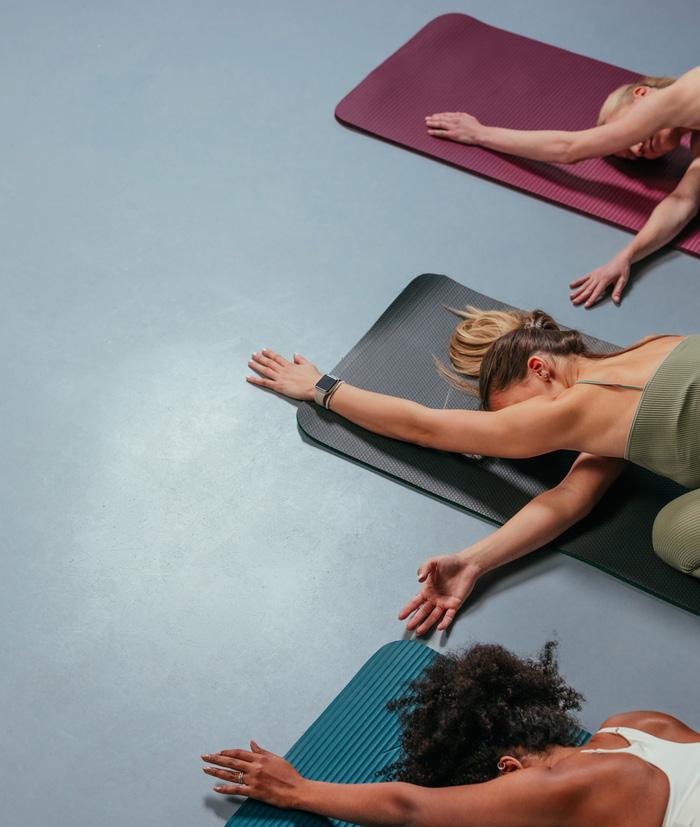Understanding the Journey of Reproductive Health
The reproductive health journey, spanning from menstruation to pregnancy, is a natural yet complex process that plays a fundamental role in many people’s lives. While often discussed in separate contexts, menstruation and pregnancy are intricately connected, representing two sides of the reproductive spectrum. This article explores the phases of menstruation, the transition to pregnancy and the importance of understanding these processes to promote health, wellbeing and inclusivity in our daily lives.
UNDERSTANDING MENSTRUATION: THE MONTHLY CYCLE
The length of a period and menstrual cycle varies between individuals and throughout a woman’s reproductive life. While the average cycle is 28-days with a 5-day period, healthy cycles can range from 21-35 days and periods from two-seven days. Factors like diet, exercise and stress can also affect cycle length. To ensure you are taking care of your menstrual health, it is always recommended that you seek further advice from your GP or a suitable health professional if you experience any unexpected and persistent change in your cycle or period length.
This is what a typical 28-day cycle may look like.
Menstrual Phase (Days 1–5)
This phase begins when an unfertilised egg causes oestrogen and progesterone levels to drop. The uterus lining, no longer needed for pregnancy, sheds as blood, mucus and tissue during your period. Symptoms such as cramps, fatigue and low energy levels are common during this time.
Follicular Phase (Days 1–13)
Overlapping with the menstrual phase, this phase sees an increase in oestrogen levels as the body prepares for ovulation. Energy levels often rise, and mood and focus may improve.
Ovulation Phase (Around Day 14)
Ovulation occurs when a mature egg is released from the ovary, which travels down the fallopian tube toward the uterus ready to be fertilised by sperm. Some individuals experience heightened energy and libido, while others may notice mild discomfort or pain known as ovulation pain. Following ovulation, the egg lasts around 12-24 hours and after a day the egg will die or dissolve if it isn’t fertilised.
Luteal Phase (Days 15–28)
During the luteal phase, hormone levels rise to keep your uterine lining thick and ready for a fertilised egg to implant. If the egg isn’t fertilised, many individuals can experience premenstrual symptoms (PMS), including mood swings, irritability, bloating and fatigue.
MANAGING MENSTRUAL SYMPTOMS AT WORK
Managing menstrual symptoms at work can be challenging, but there are steps employees can take to feel more comfortable and productive during their period.
f Keep a supply of menstrual products, pain relief medication and a water bottle at work to stay prepared.
f Stay hydrated and snack on nutrient-rich foods to combat fatigue and bloating.
f Take short breaks to stretch or practise deep breathing to ease cramps and reduce stress.
f Use discreet heat patches or portable heating pads for abdominal or back pain relief.
f If possible, discuss flexible working arrangements or adjustments with your manager for challenging days.
f Prioritise essential tasks and pace yourself to avoid overexertion.
f Practise self-compassion and listen to your body’s needs to manage symptoms effectively while staying engaged at work.
f Don’t feel that you need to struggle through very difficult symptoms if these are impacting your ability to live and work. There are treatment options available and you should discuss these with your GP.
Practise self-compassion and listen to your body’s needs to manage symptoms effectively while staying engaged at work.
PREPARING TO GET PREGNANT: STEPS TO TAKE FOR A HEALTHY JOURNEY
For individuals planning to conceive, preparation is key to ensuring a healthy pregnancy and minimising potential complications. While getting pregnant is often seen as a natural process, it’s beneficial to take proactive steps to optimise physical, emotional and financial wellbeing before embarking on this life-changing journey. Here are some considerations for preparing to get pregnant.
f Schedule a preconception check-up
Book an appointment with a GP or gynaecologist to discuss your health history, current medications and any potential risk factors. Before trying to conceive, it is important to confirm your immunity to certain diseases and health conditions which can impact the health of both the mother and the future baby during pregnancy. Examples of these are: rubella (German measles) and chickenpox (if you’re unsure whether you’ve had it). Additionally, Sickle Cell Disease (SCD) and thalassaemia are inherited blood disorders, primarily affecting people with ancestry from Africa, the Caribbean, the Mediterranean, South Asia, Southeast Asia and the Middle East. In England, free screening or blood tests for these conditions is offered during pregnancy, but you can also choose to be tested beforehand.
If you are on prescribed medications, discuss with your GP whether to continue, stop or switch to a safer alternative.
f Maintain a healthy lifestyle
Regular exercise, adequate sleep and stress management techniques like yoga or mindfulness can improve overall health and fertility. If you smoke or consume excessive alcohol, consider stopping, as these habits can affect fertility, increase the risk of miscarriage, still birth or sudden infant death syndrome and the health of a future pregnancy. Quitting smoking is hard, but there is NHS support available, and this is an important step to take to protect you and your baby.
f Adopt a balanced diet
Focus on whole foods rich in essential nutrients. It would be helpful to be a healthy weight at the start of your pregnancy. Include plenty of fruits, vegetables, whole grains, lean proteins and healthy fats. Key nutrients for fertility and a healthy pregnancy include the below.
f Folic acid: Found in leafy greens, fortified cereals and supplements, it supports early foetal development. Supplements of folic acid and vitamin D are recommended for all women when planning pregnancy to help to prevent neural tube defects such as Spina Bifida. You should ensure you do not take any supplements that contain vitamin A as it may harm the development of the foetus. The dose of folic acid depends upon any specific risk factors you may have and further information can be found here: Vitamins, minerals and supplements in pregnancy - NHS
f Iron: Found in lean meats, beans and spinach and nuts, it helps maintain healthy blood levels
f Calcium: Found in dairy products, leafy greens and fortified foods, it strengthens bones and teeth.
f Omega-3 fatty acids: Found in oily fish like salmon and mackerel, walnuts, and flax seeds, these support reproductive health.
f Track your menstrual cycle
Understanding your cycle can help identify the most fertile days if you are struggling to become pregnant. Ovulation tracking tools, such as basal body temperature thermometers or ovulation predictor kits, can help you determine the best time to try for pregnancy.
f Review workplace considerations
Review your workplace policies on pregnancy, parental leave and flexible working. Your employer should conduct a pregnancy risk assessment with you, especially if your role involves exposure to physical, biological or chemical hazards. If needed, discuss potential adjustments with your employer or occupational health team as soon as possible.
Taking these steps not only increases chances of a healthy pregnancy but also helps you feel empowered as you begin this significant life transition.
WHEN ARE YOU MOST FERTILE?
To increase your chances of getting pregnant, you need to get your fertile eggs and sperm together at the right time. You’re the most fertile on the few days each cycle around ovulation.
During an average menstrual cycle, there are 6 days when sex can result in pregnancy. This is often called the ‘fertile window’ and includes the 5 days before ovulation and the day of ovulation itself – because sperm can live up to 5 days, pregnancy can occur as a result of sex 5 days before ovulation.
Women who have a regular, 28-day cycle are likely to be fertile around day 14 of their menstrual cycle, but this won’t apply to women whose cycles are shorter or longer.
It’s possible (although not very likely) to get pregnant soon after your period finishes if you ovulate early or have a short menstrual cycle.
UNDERSTANDING PREGNANCY: THE JOURNEY OF CHANGE
Lasting approximately 40 weeks, pregnancy is divided into three trimesters, each with its own challenges and milestones.
f First Trimester (Weeks 1–12)
During the first trimester, the mother experiences significant hormonal changes to support the pregnancy. Common symptoms include nausea (often called morning sickness), fatigue, breast tenderness and mood swings. Although the uterus begins to expand, these physical changes are usually not visible to others at this stage. Internally, levels of pregnancy hormones like hCG, oestrogen and progesterone rise, laying the foundation for a healthy pregnancy.
For the baby, this is a period of rapid development. By the end of the first trimester, the baby measures about 5-6cm in length – about the size of a lime! Major organs, such as the heart, brain and spinal cord, begin to form, and the heartbeat can often be detected by around week six. By week 12 your baby is starting to look more like a little person.
f Second Trimester (Weeks 13–26)
The second trimester is often referred to as the ‘golden period’ of pregnancy for many mothers, as energy levels tend to improve and nausea often subsides. Physical changes become more noticeable as the baby bump grows, and many mothers first feel the baby’s movements, known as quickening, between weeks 18 and 22. Increased blood flow can give the skin a glowing appearance, but some mothers may also experience discomforts such as varicose veins or leg cramps.
For the baby, growth continues at a remarkable rate. By the end of this trimester, the baby is around 30cm long (about the length of a spaghetti squash)
and weighs about 900g. The skeleton strengthens and features such as hair, eyebrows and eyelashes begin to form. The baby’s kidneys start to produce urine and the ability to swallow develops. Hearing also matures during this stage, allowing the baby to respond to sounds from the outside world.
f Third Trimester (Weeks 27–40)
In the final trimester, the growing baby can cause increased discomfort, reaching the size of a watermelon by week 40. Common issues include back pain, swelling in the hands and feet, heartburn and trouble sleeping. Fatigue often returns as the due date approaches.
For the baby, this trimester is focused on growth and preparation for life outside the womb. The lungs mature, enabling the baby to breathe independently after birth and fat layers develop to help regulate body temperature. The baby typically moves into a head-down position in preparation for delivery, ready for the big day.
CHILDBIRTH AND POSTPARTUM RECOVERY
Childbirth involves three stages: labour, delivery of the baby and delivery of the placenta – each requiring physical and emotional effort.
f The first stage of labour begins with regular contractions and ends when the cervix is fully dilated (10 cm). Early labour may last several hours or even days, with mild contractions and gradual dilation. Active labour is more intense, with stronger and more frequent contractions. This phase often requires focused breathing, movement or other pain management techniques, including medical interventions like an epidural if chosen.
f In a vaginal birth, this stage begins once the cervix is fully dilated and involves pushing to deliver the baby. The duration can vary from a few minutes to several hours, depending on factors such as the baby’s position and the birthing parent’s condition. For a C-section, this stage involves surgical delivery, where an incision is made in the abdomen and uterus to safely deliver the baby. A C-section may be planned in advance or performed as an emergency procedure if complications arise during labour.
f After the baby is born, the placenta is delivered, typically within 5–30 minutes. For vaginal births, mild contractions help expel the placenta, marking the completion of childbirth. In the case of a C-section, the placenta is carefully removed by the surgical team after the baby is delivered. Regardless of the method of delivery, this stage is essential to ensure the uterus is clear and recovery can begin.
f The postpartum period then lasts about six weeks and includes physical recovery (healing, bleeding and hormonal changes) and emotional adjustments. Prioritising rest, nutrition, emotional support and followup medical care is essential during this time.
The journey from menstruation to childbirth and beyond is a remarkable process that highlights the complexity and resilience of the human body. Understanding these interconnected stages is essential not only for those experiencing them but also for fostering greater awareness and support in society. By prioritising menstrual health, preparing the body for pregnancy, and embracing the changes that come with conception, childbirth and the postpartum period, individuals can navigate this journey with confidence and care.
Education, self-care, and compassion are the cornerstones of empowering individuals through every stage of their reproductive health journey.
Health Your Stretching for Health
UNLOCKING THE BENEFITS OF FLEXIBILITY
Stretching is often overlooked as a key component of a healthy lifestyle, yet its benefits go far beyond simply improving flexibility. Whether you’re an athlete, an office worker or someone managing chronic pain, incorporating regular stretching into your daily routine can enhance physical health, boost mental wellbeing and improve your quality of life. Here’s a closer look at why stretching deserves a place in everyone’s wellness regimen.
f Improves flexibility and range of motion
Stretching helps lengthen and loosen muscles, improving overall flexibility and allowing joints to move through their full range of motion. This is particularly important as we age, as natural stiffness can develop over time, leading to reduced mobility. Stretching regularly can counteract this and make everyday activities easier and more comfortable.
f Reduces muscle tension and pain
Tight muscles can lead to discomfort, tension and even chronic pain, particularly in areas like the neck, shoulders and lower back. Stretching helps release this tightness by increasing blood flow to the muscles, relieving knots and promoting relaxation. For those who sit for long periods, stretching can counteract the effects of prolonged inactivity by targeting stiff areas and improving posture.
f Enhances physical performance
Stretching is essential for anyone engaging in physical activity. Dynamic stretches before exercise prepare your muscles for movement, reducing the risk of injury, while static stretches after a workout aid in recovery by preventing soreness and stiffness. Whether you’re lifting weights, running or playing a sport, stretching can improve your strength, speed and coordination by keeping your muscles supple and responsive.
f Promotes better posture
Poor posture is a common issue in our screen-centric world, often caused by tight muscles and imbalances in the body. Stretching can correct this by releasing tension in overworked areas, such as the chest and shoulders, and strengthening weaker muscles, like those in the upper back. Over time, stretching can help align your body properly, allowing you to stand and sit with greater ease and confidence.
f Reduces stress and boosts mental wellbeing
Stretching isn’t just a physical practice, it’s also deeply connected to mental health. The slow, controlled movements of stretching encourage mindfulness and relaxation, helping to reduce stress and anxiety. Stretching releases endorphins, the body’s natural “feel-good” chemicals, which can uplift your mood and improve mental clarity. Incorporating stretching into your day can serve as a simple yet effective way to unwind and centre yourself.
f Supports healthy circulation
Stretching stimulates blood flow, which delivers oxygen and nutrients to your muscles and tissues. This improved circulation aids in the removal of waste products, reduces inflammation and promotes faster recovery from physical exertion. Better circulation can also have long-term benefits for cardiovascular health, keeping your body functioning optimally.
GETTING STARTED WITH STRETCHING
The beauty of stretching is that it requires no special equipment and can be tailored to your individual needs and fitness level. Here are a few tips to help you get started.
f Warm up first: Stretching cold muscles can lead to strain. Start with light activity, such as walking, to get your blood flowing.
f Focus on major muscle groups: areas like the neck, shoulders, back, hips and legs, as these tend to hold the most tension.
f Breathe deeply: Controlled breathing enhances relaxation and helps you get the most out of each stretch.
f Be consistent: Aim to stretch at least 2–3 times per week or daily if possible, to experience lasting benefits.
f Listen to your body: Stretch to the point of mild tension, not pain, and hold each stretch for 15–30 seconds.
Whether you’re a beginner or an enthusiast, making stretching a regular part of your routine can help you move better, feel better and live better.
Stretching isn’t just a physical practice, it’s also deeply connected to mental health.
RESOURCES
f Periods and fertility in the menstrual cycle | NHS
f Stages of Menstrual Cycle: Menstruation, Ovulation, Hormones | Healthline
f Right Time For Sex , When Do You Ovulate ? | Your Fertility
f Ovulation calculator: When might you be most fertile? | Tommy’s
f Week-by-week guide to pregnancy - Start for Life | NHS
f Tiny seed to giant watermelon: How big your baby is this week | BabyCenter
f What are the different stages of pregnancy? | Bupa
f Understanding the Menstrual Cycle | New Direction Fertility Centers
f The importance of stretching | Harvard Health
f Stretching: Focus on flexibility | Mayo Clinic
f 9 Benefits of Stretching: How to Start, Safety Tips, and More | Healthline
NEXT ISSUE:
f Eye Health
f Migraine Awareness
f National Inclusion Week
At Health Partners we offer a full range of tailored health and wellbeing services.
Our thinking is innovative. We constantly develop new responses and tools designed to address the health and wellbeing challenges that face your business and people.
Our commitment is total. We invest in our services, creating new ones and keeping in step with every client. We constantly explore new ways of working and make no compromises in the quality of our services.
Simply put, we are here to help people be their best.
















